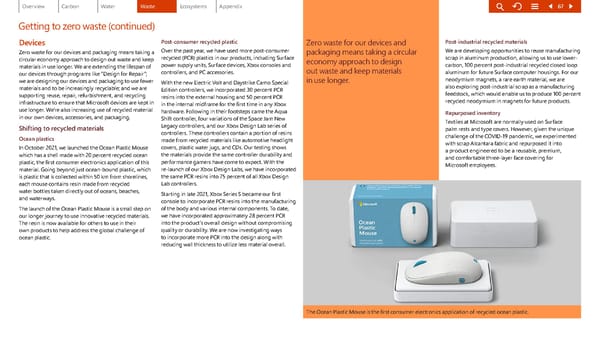Getting to zero waste (continued) Devices Zero waste for our devices and packaging means taking a circular economy approach to design out waste and keep materials in use longer. We are extending the lifespan of our devices through programs like “Design for Repair”; we are designing our devices and packaging to use fewer materials and to be increasingly recyclable; and we are supporting reuse, repair, refurbishment, and recycling infrastructure to ensure that Microsoft devices are kept in use longer. We’re also increasing use of recycled material in our own devices, accessories, and packaging. Shifting to recycled materials Ocean plastics In October 20 21, we launched the Ocean Plastic Mouse which has a shell made with 20 percent recycled ocean plastic, the fi rst consumer electronics application of this material. G oing beyond just ocean-bound plastic, which is plastic that is collected within 50 km from shorelines, each mouse contains resin made from recycled water bottles taken directly out of oceans, beaches, and waterways. The launch of th e Ocean Plastic Mouse is a small step on our longer journey to use innovative recycled materials. The resin is now available for others to use in their own products to help address the global challenge of ocean plastic. Post-consume r recycled plastic Over the pas t year, we have used more post-consumer recycled (PCR) plastics in our products, including Surface power supply units, Surface devices, Xbox consoles and controllers, and PC accessories. With the new E lectric Volt and Daystrike Camo Special Edition controllers, we incorporated 30 percent PCR resins into the external housing and 50 percent PCR in the inter nal midframe for the first time in any Xbox hardware. Following in their footsteps came the Aqua Shift cont roller, four variations of the Space Jam New Legacy con trollers, and our Xbox Design Lab series of controllers. These controllers contain a portion of resins made from recycled materials like automotive headlight covers, plastic water jugs, and CDs. Our testing shows the materials provide the same controller durability and performance gamers have come to expect. With the re-launch of our Xbox Design Labs, we have incorporated the same PCR resins into 75 percent of all Xbox Design Lab controllers. Starting i n late 2021, Xbox Series S became our first console to i ncorporate PCR resins into the manufacturing of the body and various internal components. To date, we have incorporated approximately 28 percent PCR into the product’s overall design without compromising quality or durability. We are now investigating ways to incorporate more PCR into the design along with reducing wall thickness to utilize less material overall. Zero waste for our devices and packaging means taking a circular economy approach to design out waste and keep materials in use longer. Post-industrial recycled materials We are developing opportunities to reuse manufacturing scrap in aluminum production, allowing us to use lower- carbon, 100 percent post-industrial recycled closed loop aluminum for future Surface computer housings. For our neodymium magnets, a rare earth material, we are also exploring post-industrial scrap as a manufacturing feedstock, which would enable us to produce 100 percent recycled neodymium in magnets for future products. Repurposed inventory Textiles at Microsoft are normally used on Surface palm rests and type covers. However, given the unique challenge of the COVID-19 pandemic, we experimented with scrap Alcantara fabric and repurposed it into a product engineered to be a reusable, premium, and comfortable three-layer face covering for Microsoft employees. The Ocean Plastic Mouse is the first consumer electronics application of recycled ocean plastic. 67
 Environmental Sustainability Report | Microsoft Page 66 Page 68
Environmental Sustainability Report | Microsoft Page 66 Page 68